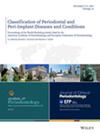Prevalence, incidence, systemic, behavioral, and patient-related risk factors and indicators for peri-implant diseases: An AO/AAP systematic review and meta-analysis
Abstract
Background
A profound understanding of the epidemiology of peri-implant diseases (PIDs) is essential for the development of preventive approaches to mitigate the occurrence and progression of peri-implant biological complications. The present systematic review and meta-analysis aimed to assess the incidence, prevalence, systemic, behavioral, and patient-related risk indicators and factors for PIDs in adult patients with dental implants.
Methods
Clinical studies assessing the prevalence, incidence, systemic risk indicators, and risk factors for PIDs were considered eligible for inclusion. MEDLINE–PubMed, EMBASE, Cochrane Central Library, and ClinicalTrials.gov electronic databases were searched for published articles. Pooled data analyses were performed using random-effects models to identify risk indicators and factors for PIDs.
Results
Of 1120 potentially eligible records, 102 studies met the eligibility criteria and were included in this systematic review. Prevalence rates at the patient level for peri-implant mucositis and peri-implantitis were 46% (95% confidence interval [CI], 41–51) and 21% (95% CI, 17–24), respectively. Weighted mean incidence rates at the patient level for peri-implant mucositis and peri-implantitis were 53% and 22%, respectively, within 20 years of function. Pooled estimates identified periodontitis, obesity, and smoking habits as significant systemic risk indicators for mucositis. For peri-implantitis, the significant risk indicators were periodontitis, diabetes mellitus, smoking habits, and alcohol consumption. Only risk indicators could be identified in the selected evidence.
Conclusion
More than half of the patients treated with dental implants were affected by PIDs over a 10-year follow-up period, with peri-implant mucositis being the most prevalent condition. Periodontitis and smoking were identified as risk indicators for the development of both PIDs. Obesity was identified as a potential risk indicator for mucositis, while diabetes mellitus and alcohol consumption were recognized as potential risk indicators for peri-implantitis.
Plain Language Summary
This systematic review looked at the causes and frequency of problems around dental implants, known as PIDs, which include conditions like peri-implant mucositis (inflammation around the implant) and peri-implantitis (more serious infection around the implant). Understanding these conditions and their etiology is important for finding ways to prevent them. This research reviewed 102 studies (including 13,030 patients) to gather data on how often these problems occur and what factors might increase the risk of developing them. The meta-analyses revealed that nearly half of people with dental implants had peri-implant mucositis, and about one in five had peri-implantitis. Over a period of 20 years, the incidence rates for developing these conditions were about 53% for mucositis and 22% for peri-implantitis. The study identified certain health and lifestyle factors that could increase the risk of these conditions. For mucositis, risk factors included having gum disease (periodontitis), obesity, and smoking. For peri-implantitis, the risks were similar, with periodontitis, smoking, and diabetes and alcohol use being important factors.




 求助内容:
求助内容: 应助结果提醒方式:
应助结果提醒方式:


